Key Points:
- Identify your Organizational Objectives
- The Basics of VMware Cloud Foundation Architecture
- Choose the Most Suitable Deployment Pathway
- VMware Cloud Foundation Appliance Models
- Sizing Considerations and Infrastructure Pre-requisites
- Planning and Preparation
- Configuration, Compatibility and Connectivity Checks
- Ready to Deploy
Getting Started
Increasing demands on modern infrastructure are driving many organizations who are running vSphere-based environments to adopt VMware Cloud Foundation (VCF). A common question we are often asked is…
“What is the best approach to planning a VCF deployment?”
The answer to this question is not prescriptive as no two organizations are ever the same. Every organization is driving their own set of unique initiatives, and each has their own set of outcomes which they seek to achieve. Here is an overview of some important steps to consider and some useful resources you can use to ensure your private cloud deployment is a success.
Identify your Organizational Objectives
Planning a VMware Cloud Foundation deployment is much more than merely checking a list of technical pre-requisites. A successful deployment requires stakeholders within an organization to first assess their operational readiness in supporting an internally managed private cloud. This is a super important step and includes (but is not limited to) assessing organisational structures, people, skills and processes as well as your technical maturity level.
The VMware Private Cloud Maturity Model Assessment is a recommended first step. By completing a holistic assessment of your objectives, you can clearly identify your strengths and highlight where improvements need to be made.
The assessment tool gathers information through a series of questions, and analyses the data collected across the following disciplines:
- Private Cloud Vision and Strategy
- Business Outcomes and Goals
- Leadership, Governance and Processes
- People, Tools and Enablement
- Security, Operations and Compliance
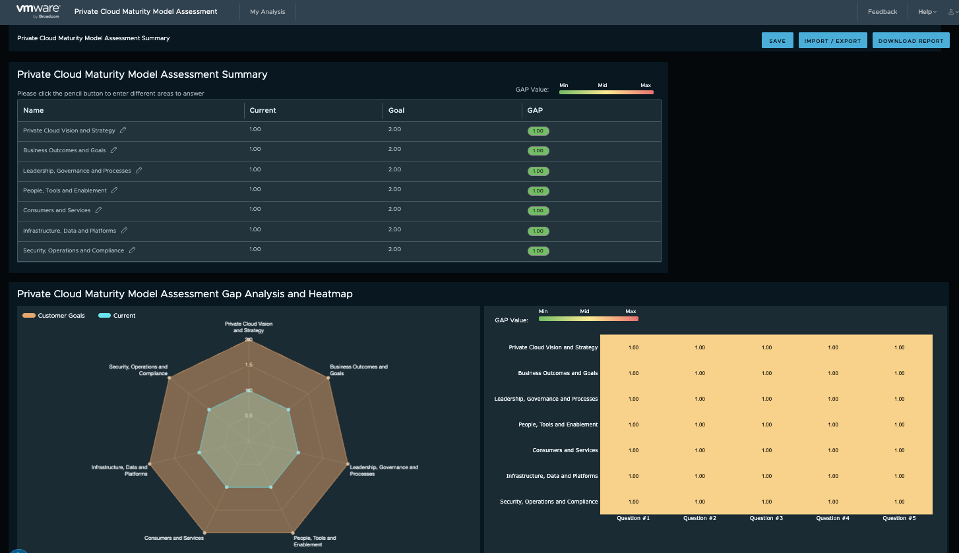
Image: This sample shows the template used when performing a Private Cloud Maturity Model Assessment
By understanding both the current and desired future state, a VMware Private Cloud Maturity Model Assessment helps create a roadmap for private cloud adoption and ensures an organization’s private cloud strategy best aligns with their overall business objectives. The best outcomes can be achieved when completing a VMware Private Cloud Maturity Model Assessment together with Broadcom or with a Broadcom partner.
The Basics of VMware Cloud Foundation Architecture
Cloud Foundation is built upon a flexible architecture which caters to a broad ecosystem of vendor infrastructure and partner solutions. To gain a greater understanding of Cloud Foundation architecture we recommend you look at the VMware Cloud Foundation Design Guide.
At a simplistic level, here are some key constructs which are important to understand.
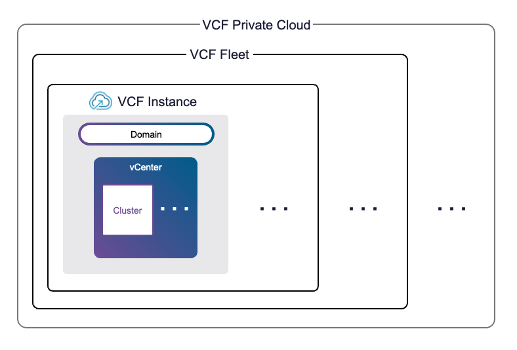
Image: Shows the high-level relationship between Clusters, vCenter Servers, Workload Domains, VCF Instances, VCF Fleets and VCF Private Clouds
Cloud Foundation is built upon vSphere. Each ESX host is configured as part of a cluster which is managed by a vCenter Server. None of this changes when adopting VMware Cloud Foundation. Your workloads can be managed in the same way utilizing your existing skillsets and the integration of familiar VMware software.
At the core of VCF architecture is the construct of a workload domain. Each workload domain is built with its own vCenter Server for management. A VCF Instance can comprise of multiple domains; a VCF Fleet can comprise of multiple VCF Instances and a VCF Private Cloud can consist of multiple VCF Fleets.
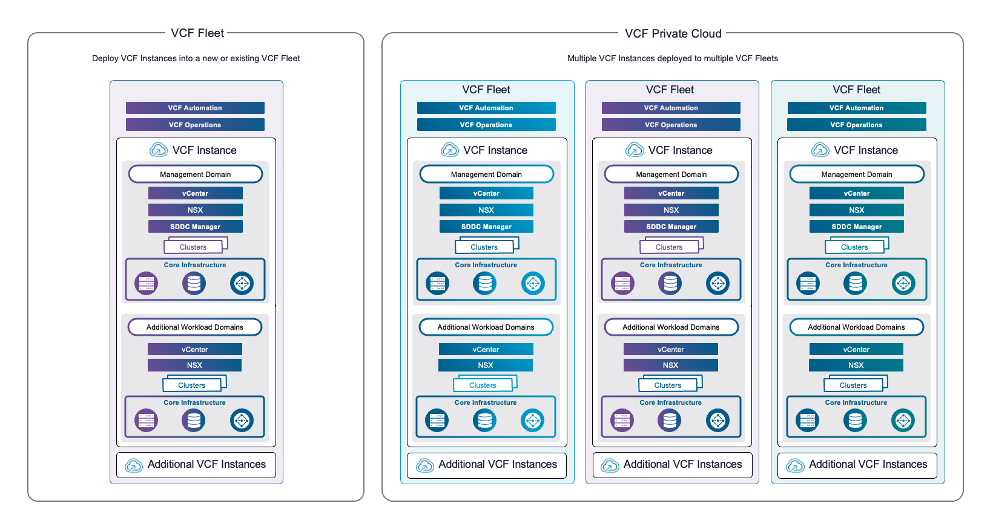
Image: Detailed relationships between VCF Instances, Domains and Management components with VCF Fleets and VCF Private Clouds
VCF Instances:
The first vSphere cluster of a VCF instance is configured as part of a management domain and is used to host the management components. Each VCF instance is configured with a single management domain which is used to house VCF core management components which includes a SDDC Manager appliance. Additional virtual infrastructure (VI) workload domains can be created to scale a deployment. Again, each workload domain is configured with its own vCenter Server and a single/shared NSX instance. Workload domains are deployed to separate different workload types and can comprise of clusters of hosts which can be configured to meet the requirements of a given set of workloads.
VCF Fleets:
A VCF fleet can be comprised of one or more VCF instances and is managed by a single set of fleet-level management components. Fleet management components comprise of a single instance of VCF Operations and a single instance of VCF Automation. The VCF Operations and VCF Automation instances can be used across all domains within a VCF instance and across one or more VCF instances. A VCF fleet can be deployed across a single region or a dual region deployment.
Fleet Management within VCF Operations includes the configuration and ongoing management of the following capabilities across all VCF instances configured as part of a VCF fleet.
- Single Sign-On and Centralized Identity Management
- Password and Certificate Management
- Configuration Management
- Tag Management
- Lifecycle Management
- License Management
VCF Private Clouds:
A VCF Private Cloud is the highest level of management and consumption for the underlying software defined data center resources. A VCF Private Cloud can contain one or more VCF Fleets.

Choose the Most Suitable Deployment Pathway
One of the first decisions to be made prior to commencing a deployment is to determine your starting point and deployment pathway.
VMware Cloud Foundation 9.0 caters to a set of different deployment pathways which simplify the adoption of VCF. VCF 9.0 provides a set of streamlined UI-driven workflows for deployment within the VCF Installer and from VCF Operations.
By understanding the different pathways available you can determine your best approach for implementation.
Deployment pathways include:
- Deploy a new VCF instance
- Converge an existing vCenter deployment to a VCF management domain
- Upgrade an existing VCF 5.x instance to VCF 9.0
- Import a vSphere 9.0 environment into an existing VCF 9.0 deployment
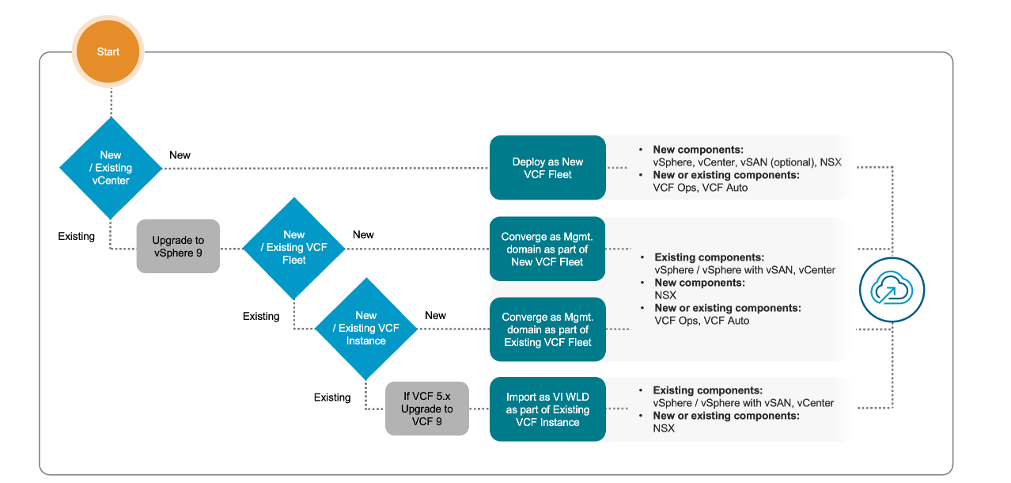
Image: VCF 9.0 deployment pathways
VMware Cloud Foundation Appliance Models
The VM appliances for a new VCF Operations, VCF Automation and NSX instances can be deployed using a Simple appliance model (single node) or a High Availability appliance model.
A High Availability model is recommended for production environments. When deployed using the High Availability model 3x NSX Manager nodes, 3x VCF Operations nodes and 3x VCF Automation nodes are deployed. 3x appliances are also configured for VCF Operations for Logs and vSphere Kubernetes Services (VKS).
To gain a deeper understanding of the VMware Cloud Foundation deployment pathways and appliance models please take a look at my last blog:
Deployment Pathways for VMware Cloud Foundation 9
Sizing Considerations and Infrastructure Pre-requisites
Ensuring that your underlying infrastructure has the capacity available to support your VMware Cloud Foundation appliances is an important part of the planning process.
The tables assume a High Availability appliance model is being used.
At a minimum the following three (3) core VCF components are deployed. These sizing recommendations apply to VCF instances where the VCF Operations and VCF Automation appliances reside on infrastructure within another VCF instance within the same VCF fleet.

1 Table 1 above is only applicable to the deployment of a new VCF management domain in an existing VCF fleet. This table also assumes that NSX is deployed using the High Availability appliance model. Optional appliances such as NSX Edges have been excluded.
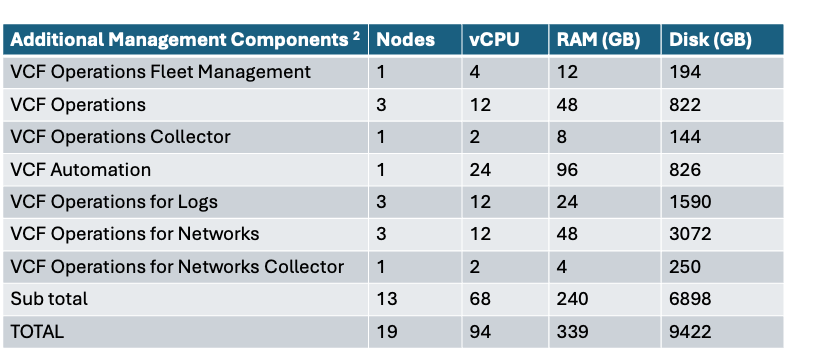
2 Table 2 above assumes a new VCF management domain instance is deployed as part of a new VCF fleet. Optional appliances such as NSX Edges have been excluded.

3 Table 3 above is specific to the requirements of a VI workload domain. This table also assumes a new and separate NSX instance is deployed using the High Availability appliance model. Optional appliances such as NSX Edges have been excluded.

Planning and Preparation
The VCF Planning and Preparation Workbook is downloadable from http://techdocs.broadcom.com and can be used to design, plan and size your VMware Cloud Foundation or VMware vSphere Foundation deployment. It’s important to always download a fresh copy when prior to deployment. This Microsoft Excel workbook is used as a dynamic VCF environment specification and only requires you to enter the inputs for the components you need based upon your own selections.
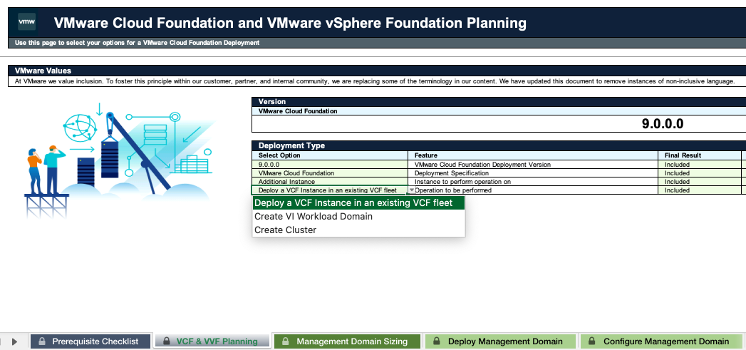
Image: VCF Planning and Preparation Workbook: The VCF & VVF Planning tab shows the first four (4) selection options
The VCF Planning and Preparation Workbook has been redesigned for VMware Cloud Foundation 9.0 and can be used to accomodate an expanded range of different deployment topologies.
Planning the initial implementation of a new VCF instance.
- Planning the initial implementation of a new VCF instance.
- Deploy a new VCF fleet
- Create a VI workload domain
- Planning the deployment of additional VCF instances.
- Deploy a VCF instance in an existing fleet
- Create a VI workload domain
- Planning the creation of a new cluster(s).
- Post-deployment operations.
- NSX network connectivity
- vSAN stretched clusters
- VCF authentication
- VCF Operations for Logs and VCF Operations for Networks
How do you use the VCF Planning and Preparation Workbook?
The VCF Planning and Preparation Workbook can be easily shared so that multiple stakeholders can contribute and collaborate on the desired configuration and design.
For new VCF Instances, users will only need to complete the VCF & VVF Planning tab and the following three (3) tabs for management, deployment and configuration of the management domain.
Once the applicable drop-down selections have been made on the VCF & VVF Planning tab, the relevant selections on the following tabs are unmasked. This helps direct to user to complete their own custom inputs on all remaining green cells.
As noted earlier, the VCF Planning and Preparation workbook can also be used when planning a new VCF instance in an existing VCF fleet, planning new clusters as well as a number of post deployment planning operations.
Configuration, Compatibility and Connectivity Checks
One of the final sets of steps to complete prior to deployment is to check:
- Your desired configuration is valid and is supportable and does not exceed the limits set with Broadcom’s configuration maximums.
- Your existing or desired hardware platform, infrastructure and management components are compatible, certified and supported for use with VMware Cloud Foundation. The Broadcom Compatibility Guide is a useful resource and provides a detailed list of supported infrastructure and software which can be used.
- The VMware Ports and Protocols tool is a portal that enables you to view all the ports needed by various VMware products, solutions, and services in a single pane. You can select all VMware products that you intend to deploy in your environment from the side panel, and this tool generates a list of ports along with other associated information such as the protocol, service description, source, and destination.
Ready to Deploy
Start by transferring the inputs you collected from the VCF Planning and Preparation Workbook and enter these into the VCF Installer Appliance when installing a VCF instance. When performing post-deployment operations (For example: workload domains, clusters, edge deployments etc) you can follow a similar process to enter the inputs you collected into VCF Operations.
In both cases the inputs collected from the VCF Planning and Preparation Workbook have been ordered in the same sequence in which they can be entered into the inbuilt UI-driven workflows.
Further Reading and Additional Resources
Gain a better understanding of VCF Deployment Pathways:
https://blogs.vmware.com/cloud-foundation/2025/07/03/vcf-9-0-deployment-pathways/
Refer to the VMware Cloud Foundation Design Guide for further detail on VCF Architecture:
https://techdocs.broadcom.com/us/en/vmware-cis/vcf.html
Refer to the VMware Cloud Foundation Deployment Guide for further detail on VCF deployment options:
https://techdocs.broadcom.com/us/en/vmware-cis/vcf.html
Refer to the VMware Configuration Maximums tool for further detail on supported configurations for compute, storage and networking:
https://configmax.broadcom.com/home
Check your infrastructure is compatible, certified and supported with VMware Cloud Foundation:
https://compatibilityguide.broadcom.com
Access the VMware Hands on Labs to familiarize yourself with VMware Cloud Foundation capabilities:
https://labs.hol.vmware.com/HOL/catalog
Discover more from VMware Cloud Foundation (VCF) Blog
Subscribe to get the latest posts sent to your email.



